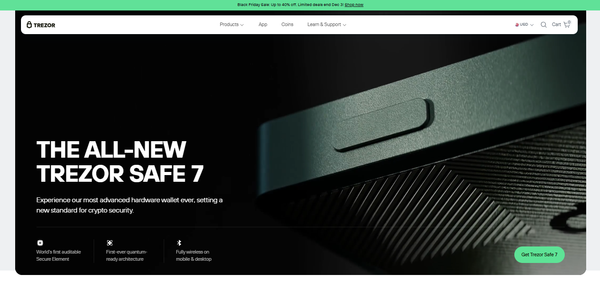Trezor® Hardware Wallet | Getting started — Trezor™
Trezor® Hardware Wallet | Getting Started — Trezor™ 💎🔐
Welcome to the Future of Crypto Security! 🚀
Cryptocurrency is the future of finance 🌐, but with great power comes great responsibility. Protecting your digital assets is crucial, and that's where Trezor® Hardware Wallet comes into play. In this guide, we’ll walk you through everything you need to get started with Trezor™, from setup to best security practices, using a simple, colorful, and emoji-friendly format.
Why Trezor®? 🤔
With digital wallets, security is everything. Trezor® is a hardware wallet designed to protect your crypto offline, making it almost impossible for hackers to access your funds. Unlike online wallets (hot wallets) 🌐, Trezor stores your private keys offline, giving you full control and peace of mind.
Benefits at a glance:
- 🔐 Maximum Security – Offline storage for your crypto keys.
- 🌈 User-Friendly Interface – Easy setup and management.
- 🔄 Supports Multiple Cryptos – Bitcoin, Ethereum, and hundreds more.
- 💾 Backup & Recovery – Restore your wallet if lost or damaged.
Colors for UI inspiration:
- Primary: #4CAF50 (green for security & success)
- Secondary: #2196F3 (blue for trust & reliability)
- Accent: #FFC107 (yellow for attention & alerts)
Unboxing Your Trezor™ 📦
Opening your Trezor® is like opening a treasure chest! ✨ Inside you’ll find:
- Trezor® Device (Model T or One)
- USB Cable 🔌
- Recovery Seed Cards 📝
- Instruction Manual 📚
💡 Tip: Always check the authenticity seal before first use. If broken, do not use the device and contact Trezor support.
Step 1: Connect & Install 🖥️
- Connect Trezor® to your computer using the USB cable.
- Open trezor.io/start in your browser. 🌐
- Follow on-screen instructions to install Trezor Bridge, the software that allows your computer to communicate with the device.
Pro Tip: Use a clean, secure computer free from malware for the initial setup. 🛡️
Step 2: Initialize Your Wallet 🔧
Trezor™ offers two main options:
- Create a New Wallet ✨
- Recover Existing Wallet 🔄
Creating a new wallet:
- Choose a strong PIN (do not use birthdays or repeated numbers!) 🔢
- Trezor™ generates a 12-24 word recovery seed 📝
- Write it down carefully and store it securely offline.
Important: Never share your recovery seed online! Anyone with access can steal your crypto. 🚫
Step 3: Managing Cryptocurrencies 💰
Trezor® supports a wide variety of cryptocurrencies including:
- Bitcoin (BTC) ₿
- Ethereum (ETH) Ξ
- Litecoin (LTC) Ł
- And more…
You can send, receive, and exchange crypto using the Trezor Suite software or compatible wallets like Electrum. 💻
Color Tip for Transaction Highlights:
- Incoming Transactions: #4CAF50 (green)
- Outgoing Transactions: #F44336 (red)
- Pending Transactions: #FFC107 (yellow)
Step 4: Security Features 🔐
Trezor® is packed with features to keep your assets safe:
- PIN Protection – Prevents unauthorized access.
- Passphrase Option – Extra security layer, like a “25th word”.
- Recovery Seed – Restore your wallet if lost.
- Firmware Updates – Keep your device updated for the latest protection. 🔄
💡 Pro Security Tip: Enable passphrase protection and keep a secure offline backup. Treat your recovery seed like gold. 🏆
Step 5: Using Trezor Suite App 📲
The Trezor Suite app provides a colorful, intuitive interface for:
- Checking balances 📊
- Sending & receiving crypto 💌
- Portfolio tracking 📈
- Firmware updates 🔄
Emoji Guide for Portfolio Tracking:
- 🔵 BTC (Blue)
- 🟣 ETH (Purple)
- 🟠 LTC (Orange)
The interface mirrors the device’s simple layout, ensuring no confusion while managing your crypto.
Tips for Safe Crypto Practices 🧠💡
- Never share your recovery seed – Treat it as your master key. 🗝️
- Use a strong PIN – Avoid predictable combinations. 🔢
- Keep firmware updated – Security patches are vital. 🔄
- Verify URLs – Only use official Trezor websites to prevent phishing. 🌐
- Store backup securely – Consider a fireproof safe for recovery cards. 🔥
Troubleshooting Common Issues ⚠️
- Device not recognized: Ensure Trezor Bridge is installed and your USB cable is working.
- Forgot PIN: Use your recovery seed to reset the device.
- Firmware error: Reinstall the firmware via Trezor Suite.
Pro Tip: Always keep a secondary secure device to access your recovery seed safely. 🛡️
Advanced Features ✨
- Hidden Wallets: Create hidden wallets with a separate passphrase for added privacy. 🕵️♂️
- Multisig Support: Enhance security with multiple signatures for transactions. ✍️
- Third-party Integrations: Use with wallets like Electrum or apps supporting WebUSB. 🌐
Color Coding for Advanced Features:
- Hidden Wallets: #9C27B0 (purple for secrecy)
- Multisig: #FF5722 (orange for active action)
- Integrations: #03A9F4 (light blue for connectivity)
Final Thoughts 🏁
Getting started with Trezor® is simple, safe, and empowering. From unboxing to sending crypto, every step is designed to ensure maximum security with minimal stress.
By following this guide:
- You’ll protect your assets 🛡️
- Gain confidence in crypto management 💪
- Enjoy a user-friendly and colorful interface 🌈
Remember: Cryptocurrency is your digital gold. Treat it wisely, and Trezor™ ensures it stays secure! 🏆
Emoji Summary Guide 🎨
| Action | Emoji | Color Suggestion |
|---|---|---|
| Secure | 🔐 | #4CAF50 |
| Alert | ⚠️ | #FFC107 |
| Receive | 💌 | #2196F3 |
| Send | ✉️ | #F44336 |
| Crypto | ₿ Ξ Ł | #673AB7 |
